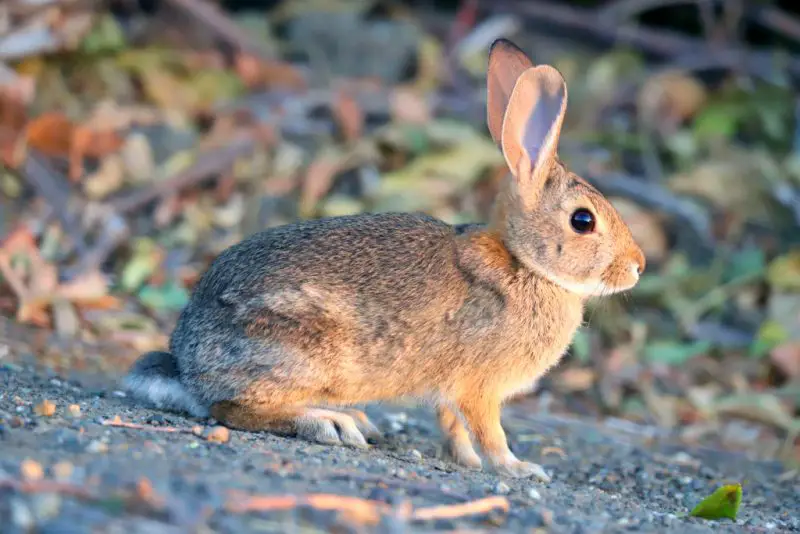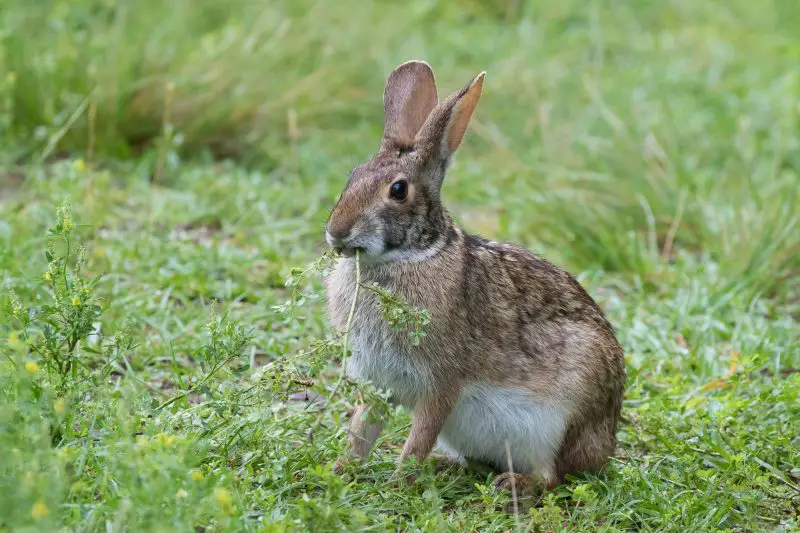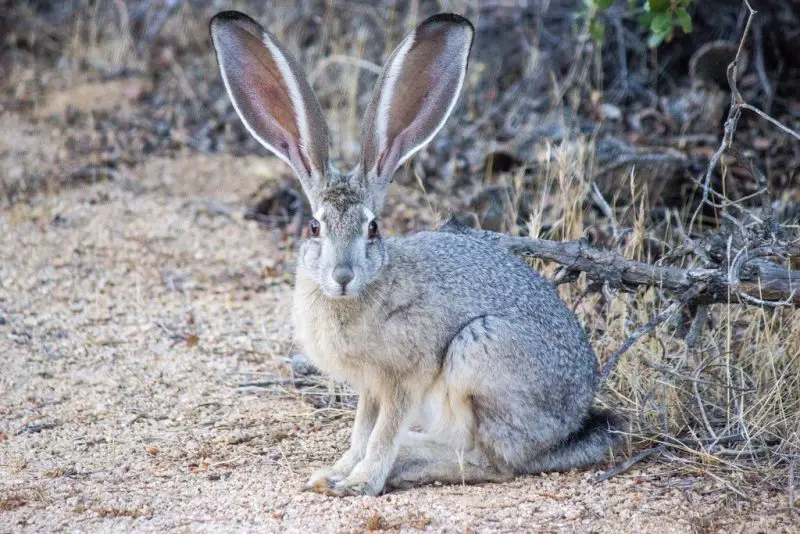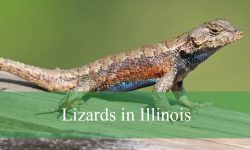Wild rabbits in Texas live in many different places, from forests to deserts. They are an important part of nature and easy to find if you know what to look for. Learning about wild rabbits in Texas helps people enjoy wildlife more.
There are six main types of wild rabbits in Texas. Each one looks different and likes different homes. This guide will show you pictures and simple ways to tell these wild rabbits in Texas apart.
Knowing about wild rabbits in Texas can make outdoor trips more fun. You will learn where they live, what they eat, and how they behave. Let’s start exploring these interesting animals found across Texas.
Common Wild Rabbits Found in Texas
Eastern Cottontail (Sylvilagus floridanus)

The Eastern Cottontail is the most commonly encountered rabbit species in Texas and across much of the eastern United States. Adults typically measure between 14 and 17 inches in length and weigh about 2 to 4 pounds. Their fur is generally a mix of brown, gray, and rust colors, with a distinct white underside and the signature fluffy white tail that resembles a cotton ball. Their large, dark eyes and upright ears give them excellent vision and hearing, essential for detecting predators.
This species is known for its solitary and mostly nocturnal behavior, although it can sometimes be seen during the early morning or late afternoon. Eastern Cottontails are crepuscular, meaning they are most active at dawn and dusk. When threatened, they rely on their speed and agility to zigzag through vegetation, confusing predators. Unlike jackrabbits, they prefer to freeze and blend into their surroundings rather than flee immediately.
Eastern Cottontails are herbivores and have a diet consisting mostly of grasses, clover, dandelions, bark, and various leafy weeds. During the winter, they often resort to eating twigs and tree bark due to the scarcity of fresh greens. Their digestive system is highly adapted to extract nutrients from fibrous plant material, and they are known to practice coprophagy—re-ingesting partially digested food to obtain more nutrients.
In Texas, the Eastern Cottontail is widespread throughout the eastern and central regions. They thrive in brushy fields, forest edges, farmland, and even suburban backyards with ample vegetation. This adaptability to a wide range of habitats is one reason for their success. They construct nests, called forms, in grassy areas and line them with fur to protect their young.
Desert Cottontail (Sylvilagus audubonii)

The Desert Cottontail is a well-adapted rabbit species found primarily in the arid and semi-arid regions of western Texas. Slightly smaller than the Eastern Cottontail, adults usually measure around 13 to 15 inches in length and weigh between 1.5 to 3 pounds. They are easily recognized by their paler, yellowish-tan fur and longer ears, which help dissipate heat in the scorching desert environment.
These rabbits are known for their elusive and shy behavior. Desert Cottontails tend to stay hidden during the hottest parts of the day and become more active in the early morning and late evening. When disturbed, they may freeze momentarily before bounding away in long, swift leaps, often reaching speeds up to 20 mph. Their excellent sense of hearing and vision aids in predator detection in open landscapes.
Desert Cottontails feed on a variety of desert vegetation, including grasses, cacti, mesquite leaves, and other drought-tolerant plants. They obtain most of their water from their food, which allows them to survive in regions where free-standing water is scarce. During particularly dry periods, they may consume cactus pads to stay hydrated.
In Texas, Desert Cottontails are most common in the western portion of the state, particularly in desert shrublands, rocky canyons, and dry grasslands. They are often found near creosote bushes, mesquite, and along arroyos. Their coloration provides excellent camouflage against the sandy and rocky terrain, helping them avoid predators like coyotes and hawks.
Swamp Rabbit (Sylvilagus aquaticus)

The Swamp Rabbit is the largest member of the cottontail genus, with adults reaching lengths of up to 20 inches and weights of 3 to 6 pounds. Their fur is dark brown and coarse, often appearing somewhat mottled with black, and their ears are shorter and rounder than other cottontails. They are also distinguished by their muscular build and powerful hind legs, which aid in swimming.
Unlike many other rabbit species, Swamp Rabbits are highly adapted to wetland environments. They are excellent swimmers and will readily take to the water when threatened. In fact, they have been observed diving underwater to escape predators. Their behavior is largely crepuscular or nocturnal, and they spend the daylight hours hiding in dense vegetation along riverbanks and marshes.
Their diet consists primarily of wetland vegetation, including grasses, sedges, reeds, and aquatic plants. During the winter or drier seasons, they may also consume twigs, bark, and fallen fruit. Swamp Rabbits rely heavily on cover from thick vegetation, not only for foraging but also for nesting and shelter.
In Texas, Swamp Rabbits are primarily found in the eastern part of the state, particularly in lowland river bottoms, swamps, bayous, and marshy areas. Their presence is closely tied to the availability of water, and they are often associated with the dense underbrush and tangled vines common in southeastern woodlands. Due to habitat loss, their range may be limited in some areas.
Black-tailed Jackrabbit (Lepus californicus)

The Black-tailed Jackrabbit is one of the most iconic and widespread hares in Texas. Unlike true rabbits, jackrabbits have longer legs and ears and are built for speed and endurance. Adults typically measure 18 to 24 inches in length and weigh between 4 to 8 pounds. They are named for the distinctive black stripe on the top of their tail, which is visible when they run.
Known for their speed, Black-tailed Jackrabbits can reach up to 35 miles per hour in short bursts and leap over 20 feet in a single bound. These hares are most active during dusk and dawn and tend to remain hidden in shallow depressions during the heat of the day. When startled, they rely on their powerful hind legs to escape predators with rapid zigzagging motions.
Their diet consists of a wide variety of plants, including grasses, shrubs, sagebrush, and agricultural crops. They are highly adaptable feeders and can survive in harsh environments with sparse vegetation. Like other hares and rabbits, they re-ingest soft fecal pellets to extract additional nutrients from their fibrous diet.
In Texas, Black-tailed Jackrabbits are abundant in the western and central parts of the state, especially in open areas such as deserts, prairies, and grasslands. They prefer dry, open landscapes with scattered shrubs or low vegetation. Their long ears not only enhance their hearing but also help regulate body temperature in the hot, arid climate.
White-tailed Jackrabbit (Lepus townsendii)

The White-tailed Jackrabbit is a larger and less common species in Texas, primarily found in the northern Panhandle region. It is one of the biggest hares in North America, measuring up to 26 inches long and weighing between 6 to 10 pounds. It is identifiable by its grayish-brown summer coat, which turns almost completely white during northern winters, and its prominent white tail.
This jackrabbit is mostly nocturnal and is known for its elusive and solitary nature. It is highly adapted to cold climates and open terrains, often using its powerful legs to flee danger at high speeds. White-tailed Jackrabbits are extremely wary and will often flush from their resting spots only when closely approached.
Their diet includes a wide array of herbaceous vegetation, such as grasses, alfalfa, and wildflowers. In agricultural areas, they may feed on crops, which sometimes brings them into conflict with farmers. During winter months, they consume bark, twigs, and dried vegetation to supplement their diet.
In Texas, the White-tailed Jackrabbit is restricted mainly to the High Plains and grasslands of the Panhandle. This species prefers open prairies, lightly grazed pasturelands, and agricultural fields with minimal tree cover. Its limited distribution in the state is due to its preference for cooler climates and specific habitat needs.
Antelope Jackrabbit (Lepus alleni)

The Antelope Jackrabbit is a rare and striking species found only in extreme southern Texas near the Mexican border. It is among the largest jackrabbits, measuring up to 24 inches in length and weighing 5 to 9 pounds. It has a light gray back, white underparts, and a rusty-orange wash along its sides and neck. Its long ears are edged in white and black and are useful for thermoregulation.
This jackrabbit is mostly active at night or during twilight hours, when it emerges to feed and avoid the daytime heat. Despite its size, it can run at high speeds and make long, leaping bounds to escape predators. It gets its name from its gait, which can resemble that of a running antelope when bounding across open terrain.
Antelope Jackrabbits feed primarily on grasses, mesquite leaves, cactus pads, and other desert-adapted plants. Like other hares, they conserve moisture by feeding on succulent vegetation and limit their activity during the hottest times of day. They also rely on their gray and tan coloration to blend into the dry scrubland.
In Texas, Antelope Jackrabbits are found in the arid thorn scrub and grasslands of the southernmost counties, such as those in the Lower Rio Grande Valley. Their range barely extends into Texas from northern Mexico, and they are considered a localized species within the state. They depend on relatively undisturbed desert habitats with scattered brush for cover.
Frequently Asked Questions About Wild Rabbits in Texas
What types of wild rabbits live in Texas
Texas is home to six species of wild rabbits and hares. These include the Eastern Cottontail, Desert Cottontail, Swamp Rabbit, Black-tailed Jackrabbit, White-tailed Jackrabbit, and Antelope Jackrabbit. Each species occupies a different habitat, ranging from eastern woodlands to desert shrublands in the west and south.
Which wild rabbit is most common in Texas
The Eastern Cottontail is the most widespread and frequently observed wild rabbit in Texas. It thrives in brushy fields, forest edges, meadows, and even suburban neighborhoods throughout the eastern and central parts of the state.
Are jackrabbits actually rabbits
Despite their name, jackrabbits are not true rabbits. They are hares, which are larger, faster, and have longer legs and ears. Unlike rabbits, hares give birth to young that are fully furred and able to move shortly after birth.
Where can I see wild rabbits in Texas
Wild rabbits can be seen throughout Texas, depending on the species. Cottontails are commonly found in grassy and wooded areas, while jackrabbits prefer open prairies and deserts. Swamp Rabbits are typically seen in wetland environments in eastern Texas.
What do wild rabbits eat in Texas
Wild rabbits in Texas are herbivores. Their diet includes grasses, clover, leaves, bark, cactus pads, and agricultural crops. The exact diet varies by species and region, but most feed during early morning or late evening when temperatures are cooler.
Are wild rabbits dangerous or harmful
Wild rabbits are not dangerous to humans. They are shy, quiet animals that prefer to avoid contact. However, they can carry external parasites like ticks or fleas, and may damage garden plants or crops if present in large numbers.
Do wild rabbits live in urban areas in Texas
Some species, especially the Eastern Cottontail, have adapted well to urban life. They are frequently seen in parks, lawns, golf courses, and vacant lots where there is sufficient ground cover and food availability.
Is it legal to hunt wild rabbits in Texas
Hunting wild rabbits is legal in Texas under state regulations. A valid hunting license is required, and hunters must observe seasonal limits and restrictions. Different species may be subject to different rules, so it is important to check with Texas Parks and Wildlife.
How do rabbits survive Texas heat
Rabbits such as the Desert Cottontail and Antelope Jackrabbit are well-adapted to Texas’s hot climate. They rest during the hottest hours of the day, stay in shaded areas or shallow scrapes, and are most active at dawn or dusk. Their large ears also help dissipate heat.
Are any wild rabbit species in Texas threatened
Most wild rabbit species in Texas have stable populations. However, the Antelope Jackrabbit is only found in a small area of southern Texas and is considered rare in the state. Habitat loss and fragmentation may affect local populations over time.






